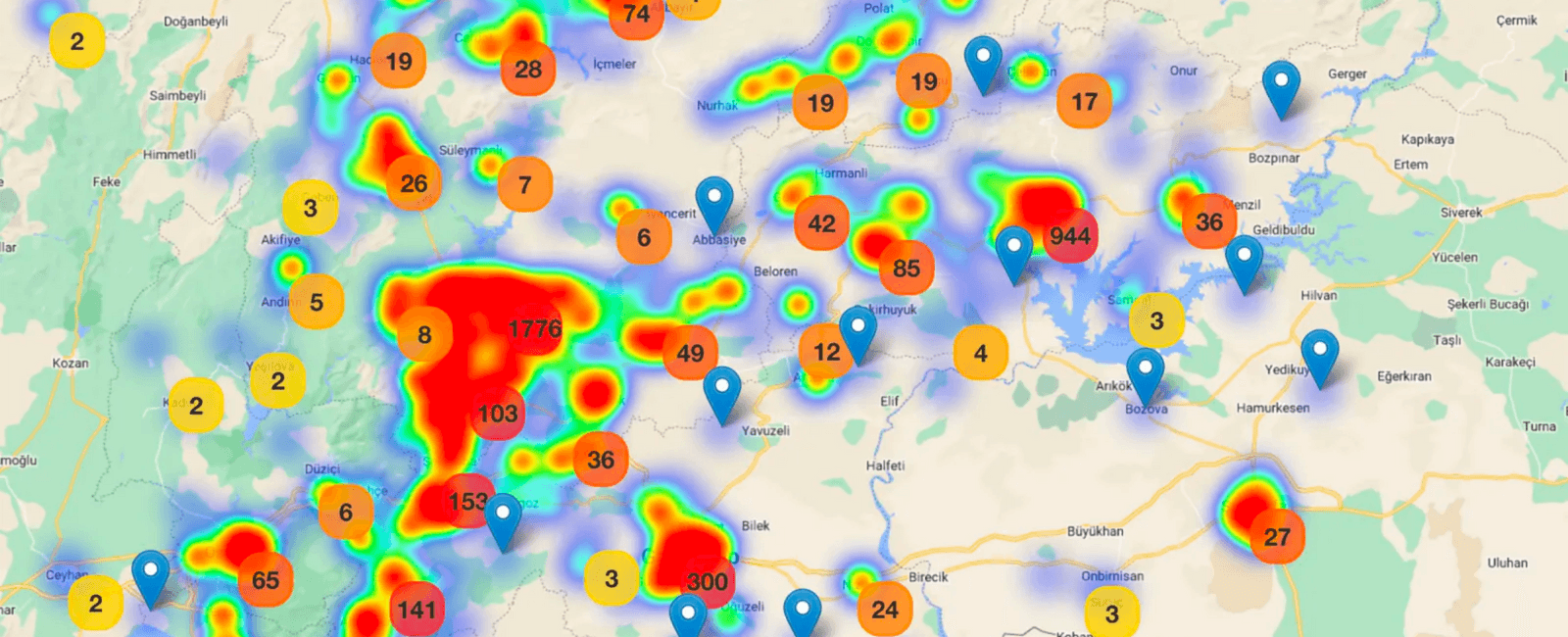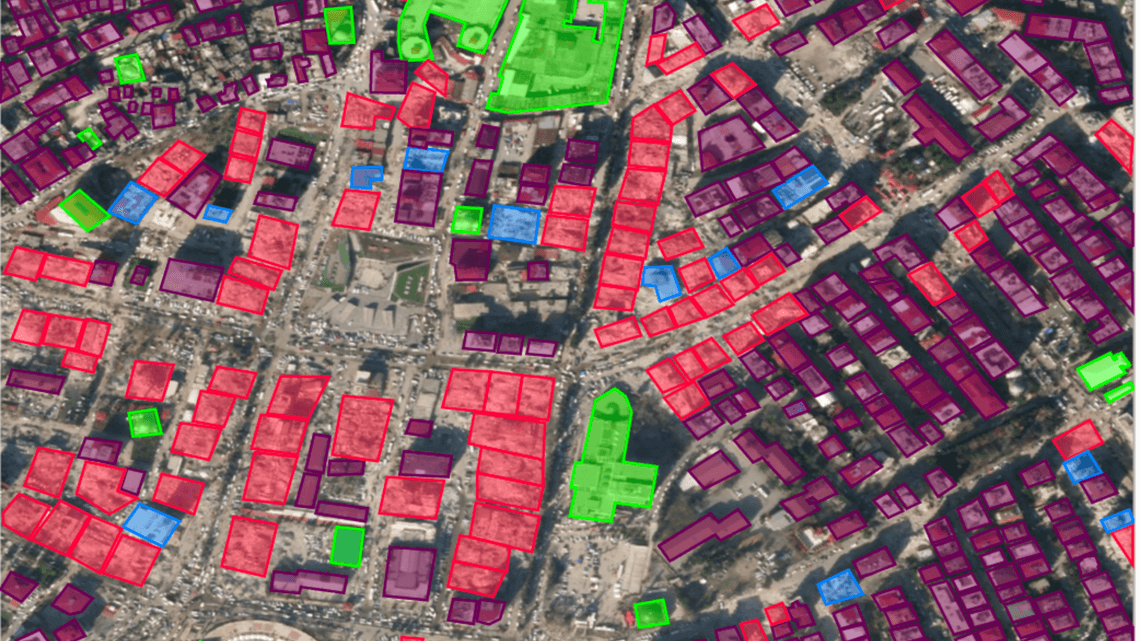Co-one's Contribution to Building Detection in Kahramanmaraş Earthquake

Over the past century, millions of people have lost their lives, and properties have been damaged due to earthquakes. An example is the Haiti earthquake that occurred in 2010. The disaster claimed around 220,000 lives and caused buildings to collapse, leaving millions homeless. Therefore, an accurate and quick assessment of the damage caused to buildings is essential to help facilitate effective response and relief efforts.
Timely detection of damaged buildings enhances effective search and rescue operations, resource allocation, and damage assessment. And there is no doubt that advanced artificial intelligence (AI) and satellite imagery technology have greatly enhanced building detection. This article highlights the importance of building detection in earthquake-affected and prone areas and explains the role of data labeling in training AI models. Also, it discusses building detection following the Kahramanmaraş earthquake and explores Co-one’s contributions to the detection of damaged buildings.
The importance of building detection in earthquake-affected areas
With devastating earthquakes that have struck different parts worldwide, the importance of building detection in earthquake-affected areas cannot be emphasized enough. Every seismic event that happens claims thousands of lives, and countless properties are destroyed. So, it is essential to develop effective building detection measures to help mitigate these losses and ensure the safety of people in earthquake-affected areas.
The significant objective of building detection in earthquake-prone regions is to identify vulnerable structures with high chances of collapsing during a seismic event. Experts can identify buildings with structural weaknesses, inadequate design, and poor construction materials through thorough assessments and advanced technologies like artificial intelligence. This information enables authorities to prioritize retrofitting efforts or condemn buildings that pose a forthcoming threat to human life. Additionally, building detection is crucial in developing evacuation plans for densely populated regions.
The Role of Building Detection in Earthquake Response
Building detection plays a significant role in earthquake response. Earthquakes can cause fatal damage to buildings, leading to loss of lives and economic consequences. Providing timely and accurate information about damaged structures helps promote effective decision-making and offers rescue operations and efficient resource allocation. Building detection is important for effective response and recovery.

Significance of accurate and timely identification of damaged buildings
Accurate and timely identification of damaged buildings helps determine areas requiring immediate attention and rescue efforts. Technologies like satellite imagery can identify damaged structures with precision. The information enables emergency personnel to prioritize their actions based on the severity of damage and potential risk to human life. Also, damage assessment enables authorities to anticipate future needs like medical assistance, temporary shelters, and other supplies.
Furthermore, accurate and timely identification of damaged buildings speed up rescue operations and minimize overall response time. By swiftly identifying the building that has been severely damaged or collapsed, the rescue can focus on areas with a higher likelihood of survivors being trapped beneath the wreckage. This operation helps increase the chances of a successful recovery.
Additionally, timely identification of damaged buildings enables officials to understand the severity of the disaster, determine the scale of response needed and coordinate efforts accordingly. The emergency team can evaluate how the situation will likely affect utilities, infrastructure, and critical facilities like hospitals, schools, and transportation networks. The information is essential for making informed decisions and implementing adequate disaster response strategies.
Impact on search and rescue operations and resource allocation
Building detection in earthquake response has significantly impacted search and rescue operations. The advanced technology helps accurately detect structures that have collapsed or suffered severe destruction. The information allows authorities to quickly identify areas where survivors may be trapped, enabling them to deploy search-and-rescue teams, equipment, and canine search units more effectively. This approach can increase the chances of finding survivors and minimize the time and resources spent on areas with minimal or no damage.
Moreover, accurate building detection is crucial during resource allocation. The information helps the response team to evaluate damage levels in different areas, allowing them to allocate resources like medical assistance, supplies, and equipment based on the extent of destruction. Thus, limited resources are distributed effectively, maximizing the response efforts.
Introduction to satellite imagery as a valuable data source
Satellite imagery plays a significant role during earthquake response, specifically in detecting and assessing damaged structures. The high-resolution images provide detailed information about the affected regions, allowing emergency personnel to prioritize their response efforts efficiently.
Satellite imagery can quickly detect damaged buildings after an earthquake. By analyzing before and after images, it enables experts to identify collapsed structures or those at risk of collapsing. With this information, the personnel can determine the areas that need immediate attention and allocate resources accordingly.
Moreover, the images allow the rescue team to plan their operations effectively by identifying safe zones that could serve as temporary shelters or emergency medical centers. Also, satellite imagery helps assess the extent of damage caused by an earthquake.
Co-one’s Data Labeling Process for Building Detection
Data labeling is a crucial process during building detection. It helps get accurate information. The accuracy and reliability of a building detection model depend on the quality of the labeled dataset. As Co-one, we provide high-quality labeled data service for the detection of earthquake-affected buildings.

Overview of Co-one as a provider of data labeling services
We base the speed and quality in data labeling service. We specialize in generating high-quality labeled datasets for various artificial intelligence (AI) applications. Co-one has high expertise and cutting-edge technology, offering an efficient and accurate process of annotating images and videos to identify buildings. We assist organizations in training and fine-tuning AI models, enabling them to unlock the full potential of their data.
Explanation of the data labeling process for building detection tasks
Co-one has developed an efficient and accurate technique for data labeling. The process starts with acquiring high-resolution images covering the target area. The images are then segmented into smaller patches using advanced algorithms to ensure maximum accuracy in detecting buildings.
After preparing the image patches, they are distributed to a team of expert annotators who mark buildings’ boundaries using specialized annotation guidelines. The annotation process needs knowledge and experience in identifying different types and shapes of constructions from various angles, ensuring precise labeling for diverse environments.
Co-one implements a rigorous quality control mechanism throughout the data labeling process to help maintain accuracy and quality. Regular checks are done to review annotations made by each annotator, providing feedback and guidance when needed.
Importance of high-quality labeled datasets for training AI models
To achieve accurate results in building detection, you require high-quality labeled datasets to train AI models efficiently. As Co-one, we have developed an approach for building detection. Our data labeling process emphasizes making precise and reliable annotations for training AI models. As Co-one, we involve skilled annotation experts who meticulously label each building in the dataset with detailed attributes like size, shape, and location. We guarantee that AI models receive accurate information to learn from by ensuring consistent quality in the entire labeling process.
High-quality labeled datasets are essential when training AI models for building detection operations. Inaccurate or inconsistent labels can lead to unreliable predictions, hindering the overall performance of these models.
Detection of Damaged / Undamaged Buildings in Kahramanmaraş Earthquake

The Kahramanmaraş earthquake happened in February 2023, leaving a trail of devastation and despair. Rescue teams rushed to save lives, but a critical task involved determining which buildings were damaged and which remained intact. The process would help effectively allocate resources and prioritize rescue efforts.
Overview of Co-one’s Contribution to Segmentation/detection studies
Co-one played a significant role in detecting damaged buildings after the Kahramanmaraş earthquake. Through our segmentation data labeling study, we offered annotated datasets mainly focusing on building detection in the affected region. Co-one’s contribution enabled developing and deploying AI models capable of quickly and accurately identifying damaged and undamaged buildings, promoting efficient response and recovery operations.
First, high-resolution satellite imagery and aerial photographs of the affected regions in Kahramanmaraş collected by afetharita.com were transmitted to Co-one. The collected data was meticulously processed and organized to create a comprehensive dataset for analysis and training. Co-one then applied advanced preprocessing techniques to ensure the collected images were clear and high-quality. The process involved removing noise, correcting distortions, and standardizing the data.
The next step involved segmentation and classification, where Co-one employed segmentation approaches to separate buildings from the surrounding environment. Co-one accurately delineated building boundaries and isolated them for further analysis using pixel-level analysis and machine-learning techniques.
After the buildings were segmented, they were classified by our expert crowdsource team in terms of damage status of each building. The team classified structures as damaged or undamaged by analyzing patterns like collapsed roofs, cracks, and structural deformations.
Conclusion
Co-one’s contribution in detecting damaged and undamaged buildings has played a significant role in assessing and understanding the extent of destruction. Our advanced algorithms and expertise in image processing enabled accurate segmentation of buildings and precise detection of damaged and undamaged structures, promoting swift and effective responses.
Using high-quality labeled datasets for building detection like those provided by Co-one promotes the accuracy and timeliness of building detection. Co-one shows the power of artificial intelligence in assisting post-disaster recovery efforts and emphasizes the benefit of timely detection for quick response and effective disaster management.


